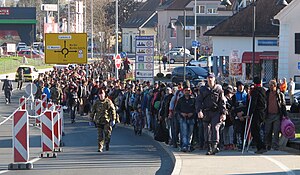
Back Menslike migrasie AF Migration ALS هجرة بشرية Arabic জনপ্ৰব্ৰজন AS Migración humana AST प्रवास AWA Халыҡтың миграцияһы BA Міграцыя насельніцтва BE Перасяленьне BE-X-OLD Миграция на населението Bulgarian
Some of the image captions in this article may require cleanup to comply with Wikipedia guidelines for succinctness. (August 2023) |


Human migration is the movement of people from one place to another[1] with intentions of settling, permanently or temporarily, at a new location (geographic region).
The movement often occurs over long distances and from one country to another (external migration), but internal migration (within a single country) is the dominant form of human migration globally.[2]
Migration is often associated with better human capital at both individual and household level, and with better access to migration networks, facilitating a possible second move.[3] It has a high potential to improve human development, and some studies confirm that migration is the most direct route out of poverty.[4]
Age is also important for both work and non-work migration.[5]
People may migrate as individuals, in family units or in large groups.[6] There are four major forms of migration: invasion, conquest, colonization and emigration/immigration.[7]
People moving from their home due to forced displacement (such as a natural disaster or civil disturbance) may be described as displaced persons or, if remaining in the home country, internally-displaced persons.
People who flee to a different country due to political, religious, or other types of persecution in their home country can formally request shelter in the host country. These people are commonly referred to as an asylum seekers. If the application is approved, their legal classification changes to that of refugees.[8]
- ^ Society, National Geographic (2010-12-14). "Introduction to Human Migration". National Geographic Society. Retrieved 2023-08-12.
- ^ World Migration Report 2020. International Organization for Migration, 2019. "The great majority of people in the world do not migrate across borders; much larger numbers migrate within countries (an estimated 740 million internal migrants in 2009)" (p. 19). "In 2019, there were an estimated 272 million international migrants globally (3.5% of the world’s population) .... it is evident that the vast majority of people continue to live in the countries in which they were born" (p. 21).
- ^ Razum, Oliver; Samkange-Zeeb, Florence (2017). "Populations at Special Health Risk: Migrants". In Quah, Stella R. (ed.). International Encyclopedia of Public Health (2nd ed.). Oxford: Academic Press. pp. 591–598. doi:10.1016/B978-0-12-803678-5.00345-3. ISBN 978-0128037089. Archived from the original on October 14, 2022. Retrieved October 11, 2022.
- ^ Kumar, Shailendra; Choudhury, Sanghamitra (2021-01-01). "Migrant workers and human rights: A critical study on India's COVID-19 lockdown policy". Social Sciences & Humanities Open. 3 (1): 100130. doi:10.1016/j.ssaho.2021.100130. ISSN 2590-2911. S2CID 234161193.
- ^ Coxhead, Ian; Cuong, Nguyen Viet; Vu, Linh Hoang (2015). "Migration in Vietnam: New Evidence from Recent Surveys" (PDF). SSRN Electronic Journal. doi:10.2139/ssrn.2752834. S2CID 34975118.
- ^ "Migrations country wise". Archived from the original on 2016-02-11. Retrieved 7 June 2014.
- ^ Caves, R. W. (2004). Encyclopedia of the City. Routledge. pp. 461. ISBN 978-0415252256.
- ^ "What is a refugee?". UNHCR. Retrieved 2023-08-12.
